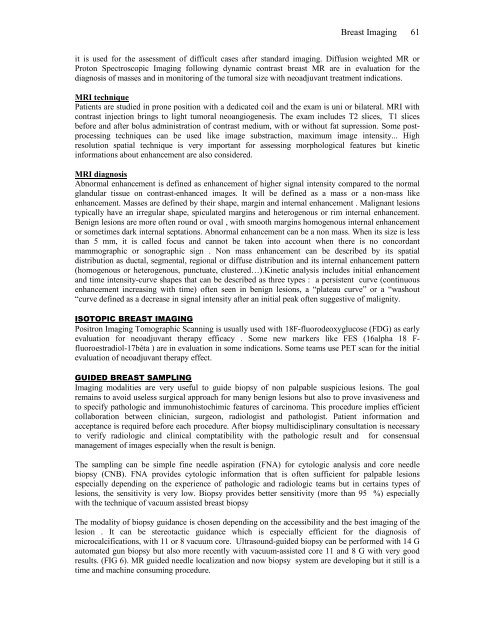Breast Cancer - Arab Medical Association Against Cancer
Breast Cancer - Arab Medical Association Against Cancer
Breast Cancer - Arab Medical Association Against Cancer
- No tags were found...
You also want an ePaper? Increase the reach of your titles
YUMPU automatically turns print PDFs into web optimized ePapers that Google loves.
<strong>Breast</strong> Imaging 61it is used for the assessment of difficult cases after standard imaging. Diffusion weighted MR orProton Spectroscopic Imaging following dynamic contrast breast MR are in evaluation for thediagnosis of masses and in monitoring of the tumoral size with neoadjuvant treatment indications.MRI techniquePatients are studied in prone position with a dedicated coil and the exam is uni or bilateral. MRI withcontrast injection brings to light tumoral neoangiogenesis. The exam includes T2 slices, T1 slicesbefore and after bolus administration of contrast medium, with or without fat supression. Some postprocessingtechniques can be used like image substraction, maximum image intensity... Highresolution spatial technique is very important for assessing morphological features but kineticinformations about enhancement are also considered.MRI diagnosisAbnormal enhancement is defined as enhancement of higher signal intensity compared to the normalglandular tissue on contrast-enhanced images. It will be defined as a mass or a non-mass likeenhancement. Masses are defined by their shape, margin and internal enhancement . Malignant lesionstypically have an irregular shape, spiculated margins and heterogenous or rim internal enhancement.Benign lesions are more often round or oval , with smooth margins homogenous internal enhancementor sometimes dark internal septations. Abnormal enhancement can be a non mass. When its size is lessthan 5 mm, it is called focus and cannot be taken into account when there is no concordantmammographic or sonographic sign . Non mass enhancement can be described by its spatialdistribution as ductal, segmental, regional or diffuse distribution and its internal enhancement pattern(homogenous or heterogenous, punctuate, clustered…).Kinetic analysis includes initial enhancementand time intensity-curve shapes that can be described as three types : a persistent curve (continuousenhancement increasing with time) often seen in benign lesions, a “plateau curve” or a “washout“curve defined as a decrease in signal intensity after an initial peak often suggestive of malignity.ISOTOPIC BREAST IMAGINGPositron Imaging Tomographic Scanning is usually used with 18F-fluorodeoxyglucose (FDG) as earlyevaluation for neoadjuvant therapy efficacy . Some new markers like FES (16alpha 18 F-fluoroestradiol-17béta ) are in evaluation in some indications. Some teams use PET scan for the initialevaluation of neoadjuvant therapy effect.GUIDED BREAST SAMPLINGImaging modalities are very useful to guide biopsy of non palpable suspicious lesions. The goalremains to avoid useless surgical approach for many benign lesions but also to prove invasiveness andto specify pathologic and immunohistochimic features of carcinoma. This procedure implies efficientcollaboration between clinician, surgeon, radiologist and pathologist. Patient information andacceptance is required before each procedure. After biopsy multidisciplinary consultation is necessaryto verify radiologic and clinical comptatibility with the pathologic result and for consensualmanagement of images especially when the result is benign.The sampling can be simple fine needle aspiration (FNA) for cytologic analysis and core needlebiopsy (CNB). FNA provides cytologic information that is often sufficient for palpable lesionsespecially depending on the experience of pathologic and radiologic teams but in certains types oflesions, the sensitivity is very low. Biopsy provides better sensitivity (more than 95 %) especiallywith the technique of vacuum assisted breast biopsyThe modality of biopsy guidance is chosen depending on the accessibility and the best imaging of thelesion . It can be stereotactic guidance which is especially efficient for the diagnosis ofmicrocalcifications, with 11 or 8 vacuum core. Ultrasound-guided biopsy can be performed with 14 Gautomated gun biopsy but also more recently with vacuum-assisted core 11 and 8 G with very goodresults. (FIG 6). MR guided needle localization and now biopsy system are developing but it still is atime and machine consuming procedure.









